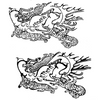The Quakers, Benjamin Franklin, and the Jersey Devil

"Mephistopheles in the Sky" by Eugène Delacroix, 1828, a possible inspiration for the Jersey Devil
For centuries, stories of a devilish winged horse have circulated across southern New Jersey, the beast supposedly stalking the vast Pine Barrens. The Jersey Devil is an unusually persistent bit of folklore, not because the creature is real but because of the complex chain of influence that gave rise to the monster’s story. The Jersey Devil is more than the usual tall tale; it is the story of political and religious schisms of the United States’ colonial period, much of the drama centering around a Quaker writer named Daniel Leeds. It was Leeds’ conflict with the wider Quaker community that set off a chain of events that spawned the Jersey Devil.
Leeds was a community member in Burlington, a Quaker enclave; he was devout in his faith but was also given to more esoteric pursuits. An astrological almanac Leeds wrote in 1687 and a sprawling theological and scientific book called The Temple of Wisdom angered the church leaders and much of his work was destroyed. Leeds turned to writing anti-Quaker diatribes and was soon accused of being a harbinger of the devil. After his death, his son Titan took over publishing his almanac, feuding with Benjamin Franklin who would jokily depict the younger Leeds as a pawn of Satan. Slowly, the Leeds name came to be associated with demonic evil.

A zodiac man. Daniel Leeds depicted a similar figure in his almanac, angering the Quaker community who linked him with the devil
This association with the devil intermingled with preexisting folklore in the area. The indigenous Lenape people had many stories of forest spirits inhabiting the Pine Barrens. The so-called “monstrous births” of women like Puritan reformer Anne Hutchinson served as proof of her angering God. When the witch hunt hysteria took hold, a story circulated of “Mother Leeds” who gave birth to a hooved, winged creature. Leeds’ name comes from Leed Points, which was named for Daniel Leeds’ family, further linking his family and what was then called the Leeds Devil.
The appearance of the Leeds Devil was partially influenced by the demon Mephistopheles, often invoked in depicting an enemy as a monster, a means of character assassination used against the Leeds. Long after both men were dead, interest in the Leeds Devil was elevated by con men who attached wings to a kangaroo and claimed it was the creature, while a spate of sightings in 1909 cemented the creature’s place in modern cryptid lore. Sightings continue to this day, but the creature is not flesh and blood. The Jersey Devil is an amalgamation of America’s colonial history, a strange product of religious feuds and political spats at the dawn of the country.
Read more!
Regal B, Esposito FJ. The Secret History of the Jersey Devil: How Quakers, Hucksters, and Benjamin Franklin Created a Monster. Johns Hopkins paperback edition. Johns Hopkins University Press; 2019.
Featured Product
Space Exposed Tomato Seeds
Cool Things!

Learn About The Newly Discovered Species of Early Humans!
In studying early human ancestors, known as “hominids,” anthropologists have historically found much wider variations from specimen to specimen than expected, particularly among other paleontological fields. A recent study argues that certain groups of hominid fossils previously thought to be an already discovered species constitute a new one entirely.

Learn About Iron Age Mummy Tattoos!
Tattoos have been a popular form of individual and societal expression for centuries around the world, making them a focal point of study for anthropologists and archaeologists. Unfortunately, the oldest examples are rarely preserved well enough for deep study, since skin usually decomposes before fossilization. In one recent case, however, new technology allowed researchers to draw new conclusions about the tattoos of one fascinating specimen: a well-preserved mummy.

Scientists Discover First Ever Ancient Roman Trilobite!
It’s well known among archaeologists that the ancient Romans had a reverence for fossils. For example, it is thought they believed mammoth bones and teeth were those of dragons and cyclopes, and thus, these items were often displayed in places of power. However, researchers in Spain recently uncovered an exceedingly rare Roman fossil artifact from an unlikely place.
Specimen Deep Dives

Old Ironsides: The USS Constitution and the Start of the U.S. Navy

The Hollywood Sign: The Story of a City's Symbol Hollywoodland

Building Disneyland
Long Form Articles

The Artist Behind the Macintosh: Susan Kare and Apple Computers
While the two Steves, Jobs and Wozniak, are the most well known faces behind Apple computers, equally important to the products and culture of the company were those who crafted the experience of using their computers through design. The most notable of these visual architects was Susan Kare, a designer responsible for “humanizing” Macintosh computers.

Can I Lick It? Yes You Can!
Have you ever been unable to tell if a fossil was really a fossil, but you were too embarrassed to admit it? Have you ever wanted to lick a fossil just because, but you didn’t want to risk judgment from your peers? Well, good news! You can kill two birds with one stone! Licking a fossil can actually help you determine if it’s the real deal or just another rock.

Is It Legal To Own a Meteorite: How to Start Your Outer Space Collection!
Meteorites are some of the rarest geological specimens to be found on Earth. Of course, since these stones are not of our world, purchasing them can sometimes be a confusing process. Is it legal to own a meteorite? In short, yes! Read on for help starting your cosmic collection!









